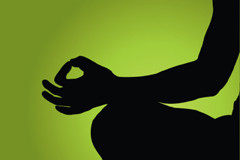Yoga may aid stroke recovery

We tend to think of yoga as exercise for youthful, limber folks. A new study from Indianapolis suggests it may also help older stroke survivors improve their balance and become more active.
Thanks to medical advances in detecting and treating stroke, the risk of dying from one is lower now than it used to be. Unfortunately, many stroke survivors are left with a disability. In fact, stroke is the leading cause of serious long-term disability in the United States.
A stroke (or “brain attack”) occurs when part of the brain stops getting the steady supply of oxygen-rich blood it needs. This can happen because of a blockage in a vessel supplying blood to the brain, or because a blood vessel in the brain breaks. Either way, the shut-off damages fragile brain tissue.
The effect of the damage depends on what part of the brain is affected. A stroke can interfere with speech, cause memory problems, or affect the movement of the arms or legs on one side of the body. Stroke also can lead to difficulty with balance and increase the risk of falls.
After a stroke, one goal of rehabilitation is to limit long-term disability. Rehabilitation programs include physical therapists to help improve strength, balance and movement, occupational therapists to work on skills need for daily living and work, and other professionals. Starting rehabilitation soon after a stroke can help improve function.
The new research from Indianapolis, which was published online in the journal Stroke, suggests that adding yoga to stroke rehabilitation may improve recovery. Yoga is a combination of poses, breathing, and meditation.
In this study, 47 mostly male stroke survivors treated at a Veterans Hospital were divided into three groups. Some took part in a twice weekly group yoga session for eight weeks. Others did the same thing, but with an at-home relaxation component. And some received standard follow-up but no yoga. All had previously completed a stroke rehabilitation program. There were several benefits in the yoga group, including:
- Improved balance
- Improved quality of life
- Reduced fear of falling
- Better independence with daily activities
Although small, this study adds to findings from other research that yoga may help stroke survivors in several ways.
Adding yoga
If you or a family member has had a stroke, yoga isn’t the first step toward recovery. Instead, consider starting a rehabilitation program as soon as your doctor says it is safe. This can speed your recovery and limit long-term disability. Once that is under way, if you want to do more, think about adding some yoga.
Before starting, talk to your doctor or therapist about whether yoga is safe for you. One thing to discuss is whether any common yoga poses might pose problems for you.
Another important part of recovering from a stroke is preventing a second one. Reducing your risk depends on what kind of stroke you had and what might have led to it. But there are some basic things that all stroke survivors can do.
- Don’t smoke.
- Control your blood pressure.
- Control your cholesterol.
- Choose a healthy diet.
- Make sure you are on the right medicines for preventing another stroke. Each case is different, so it is important to discuss this with your own doctor.
About the Author

Reena L. Pande, MD, Instructor in Medicine, Harvard Medical School
Disclaimer:
As a service to our readers, Harvard Health Publishing provides access to our library of archived content. Please note the date of last review or update on all articles.
No content on this site, regardless of date, should ever be used as a substitute for direct medical advice from your doctor or other qualified clinician.















